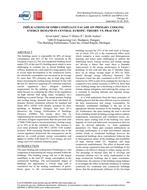
Implications of EPBD Compliant Facade on Primary Cooling Energy Demand in Central Europe: Theory vs. Practice
- Comments Off on Implications of EPBD Compliant Facade on Primary Cooling Energy Demand in Central Europe: Theory vs. Practice
- ASHRAE
Click here to purchase
The buildings sector is responsible for 40% of energy consumption and 36% of the CO2 emissions in the European Union [1].The non-residential building sector makes 25% of the total EU building stock which is more challenging to evaluate due to mixed building types (offices, hospitals etc.) and respective usage pattern. Due to recent rapid development in the commercial sector, the electricity consumption has increased in an average by more than 70% primarily due to high plug loads, hence increasing the cooling energy demand. In line with the key EU directives targeting CO2 emission reduction, current regulations have stringent insulation requirements for the building envelope. The current study focuses on evaluating the effect of the regulations on high internal load (plug loads, occupancy etc.) buildings in central Europe. The annual primary heating and cooling energy demands have been calculated by dynamic thermal simulation software for standard and future IPCC (2030) A1B climatic scenarios for three buildings in Budapest, Hungary that meet EU’s directives, the Energy Performance of Buildings Directive (EPBD). The results show that by implementing the current local regulations (TNM recast) with more stringent requirements than the previous code (7/2006 TNM) leads to increased primary cooling energy up to 10% in all the simulated cases. This increase is even more profound with IPCC (2030) A1B weather scenario. With increasing thermal insulation due to the current regulatory framework, the consequences can be adverse on overall primary energy consumption and appear to conflict with future EU’s low-energy, net zero energy and CO2 emission reduction goals.
Citation: ASHRAE/IBPSA-USA Bldg Simulation Conf, Sept 2018
Product Details
- Published:
- 2018
- Number of Pages:
- 8
- Units of Measure:
- Dual
- File Size:
- 1 file , 3 MB
- Product Code(s):
- D-BSC18-C063

